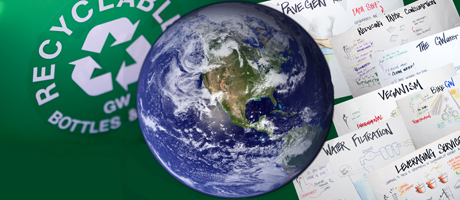Solar thermal systems slated for three GW residence halls.
By the end of the spring 2011 semester, GW will have the largest source of on-site solar power in Washington, D.C. with solar thermal systems in three GW residence halls installed by Skyline Innovations, a local solar energy company.
“We are excited to bring solar thermal systems to GW’s residence halls and have the largest solar thermal system in D.C.,” says Alicia O’Neil, senior associate vice president for operations.
A solar thermal system will be installed in Building JJ on F Street later this fall, and systems will be installed in 1959 E Street and Ivory Tower in the spring. The sunlight is converted to thermal energy. The heat is then sent to a hot water tank, which pumps out water to be used in the residence hall.
“These new solar systems work toward two key Climate Action Plan goals – using our campus as a test-bed for renewable technologies and generating 10 percent of energy from on-campus renewable sources by 2040,” Ms. O’Neil says. “These pilot systems will help us explore how to expand the future use of this technology.”
Skyline will cover all the installation costs, and GW will pay Skyline for the hot water the systems produce.
“Skyline is excited to partner with GW to bring such a substantial solar installation to the District,” says Zach Axelrod, Skyline’s chief executive officer. “The passion for sustainable development and environmental stewardship demonstrated by GW is invigorating and reassuring as we strive to bring affordable solar power to D.C.”
The solar installations are in accordance with GW’s 2010 Climate Action Plan which targets carbon neutrality by 2040. By making buildings more efficient, using cleaner energy and encouraging the GW community to do its part, the university plans to reduce its carbon emissions by 40 percent by 2025 and 80 percent by 2040. The remaining carbon emissions will be mitigated through the purchase of local offsets, such as planting trees.
The systems will reduce about 70 tons of carbon annually, which is the equivalent of removing 14 cars from the road permanently or planting more than 70 trees every year, says Mr. Axelrod.
“By capturing solar energy, the building obviates the need to consume fossil fuel energy for water heating purposes,” says Mr. Axelrod.
Return to the GW Today homepage.


